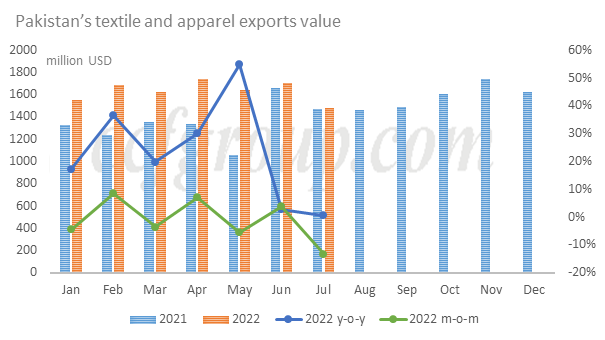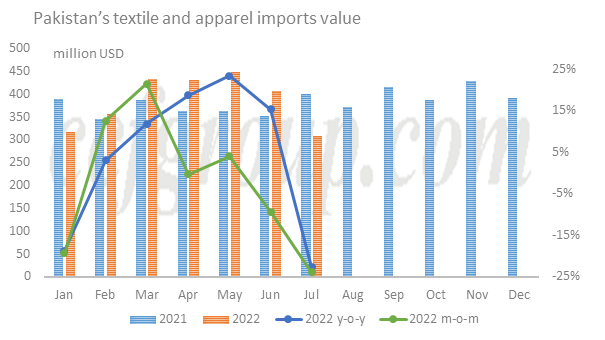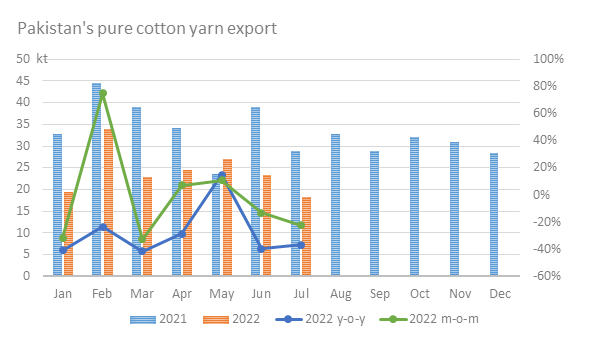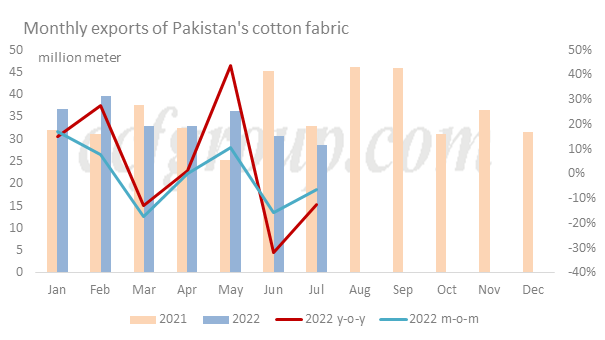Pakistan's textile and apparel exports wane sharply in Jul
1. Pakistan's textile and apparel exports declined to US$1.481billion in Jul

Pakistan's textile and apparel exports declined by US$225million to US$1.481billion in Jul 2022, down 13.21% month-on-month, and was flat compared to the same period last year. The exports of cotton yarn, cotton fabric, apparel and home textile all witnessed a sharp decline of around 20%.
2. Pakistan's textile and apparel imports retreated by nearly US$100million in Jul

As for the imports, Pakistan's textile and apparel imports in Jul amounted to US$309million, dropped by nearly US$100million month-on-month, and down 24% year-on-year, hitting the lowest level in the year. It should be noticed that, the imports decrease of raw cotton alone reached US$71million, which was the main reason for overall rapid drop. One fundamental cause was the accelerated arrival of Pakistan new cotton, which relieved Pakistan's dependence on imported cotton and pulled the local cotton prices down in Pakistan. At the same time, the exports of Pakistan's cotton exceeded zero for the first time since Feb, and totaled 455 tons in Jul. Another reason rests with the energy crisis and contracted export orders. The operating rate dropped evidently among downstream mills. Therefore, the consumption of cotton declined further.
3. Exports of Pakistan's pure cotton yarn and cotton fabric fell to a record low in Jul


In Jul 2022, Pakistan's pure cotton yarn exports volume fell to 18kt, down 5kt from Jun, and was equivalent to that in 2020 when the COVID-19 pandemic first erupted. Its cotton fabric exports also declined to a low level. Pakistan's siro-spun cotton yarn used to occupy a certain share in China's denim market, therefore its demand shrank rapidly given the recent low-priced cotton yarn in China. Later on, as Pakistan's cotton supply increases and yarn export prices drop, its exports to China is expected to pick up briefly.
4. Summary
Compared with Vietnam and Bangladesh, Pakistan's textile and apparel exports took the lead in showing the signs of weakening. The previously worried negative influence of energy crisis on Pakistan's textile and apparel industry were expanding, which had led to the sharp decline of Pakistan's earlier well-performed textile and apparel exports. On the one hand, Pakistan are facing international debt crisis caused by insufficient foreign exchanges. On the other hand, European countries are purchasing nature gases around the world at a high price, which is actually an energy encircle for developing countries. Insufficient nature gases and power supply caused a continued rise on the producing costs of yarn mills in Pakistan. Spinners were frustrated by the risk of default and order lost, therefore are inactive in taking new orders. So far, Pakistan's textile and apparel exports to Europe and U.S. are still expected to move down. While its exports to India, China, Bangladesh, Vietnam and Cambodia in the first half of this year were on the rise. Yet, situation may be divided since Aug. As India cotton going to be on China's market, and seed cotton prices drop evidently than last year, Pakistan's cotton yarn share is supposed to decline further. In all, Pakistan’s textile industry will encounter with massive difficulties in the next half of the year, and its weakened capacity to earn foreign exchanges through exports makes Pakistan rupee in more dire circumstances.
- Top keywords
- Cotton Price
- Cotton Futures Price
- Cotton Futures
- CZCE
- PTA Futures Price
- Chemical Fiber
- Polyester Prices
- Wool price
- PTA Futures
- Shengze Silk
- China
- Yarn Price
- price
- China Textile City
- Fibre Price
- Benzene Price
- Cotton
- Index
- Cotton Index
- PTA
- fabric price
- NYMEX
- Top 10
- textile industry
- Spot Cotton
- Cotton Yarn
- Polyester Price
- Futures
- PTA Price
- cotton yarn price

